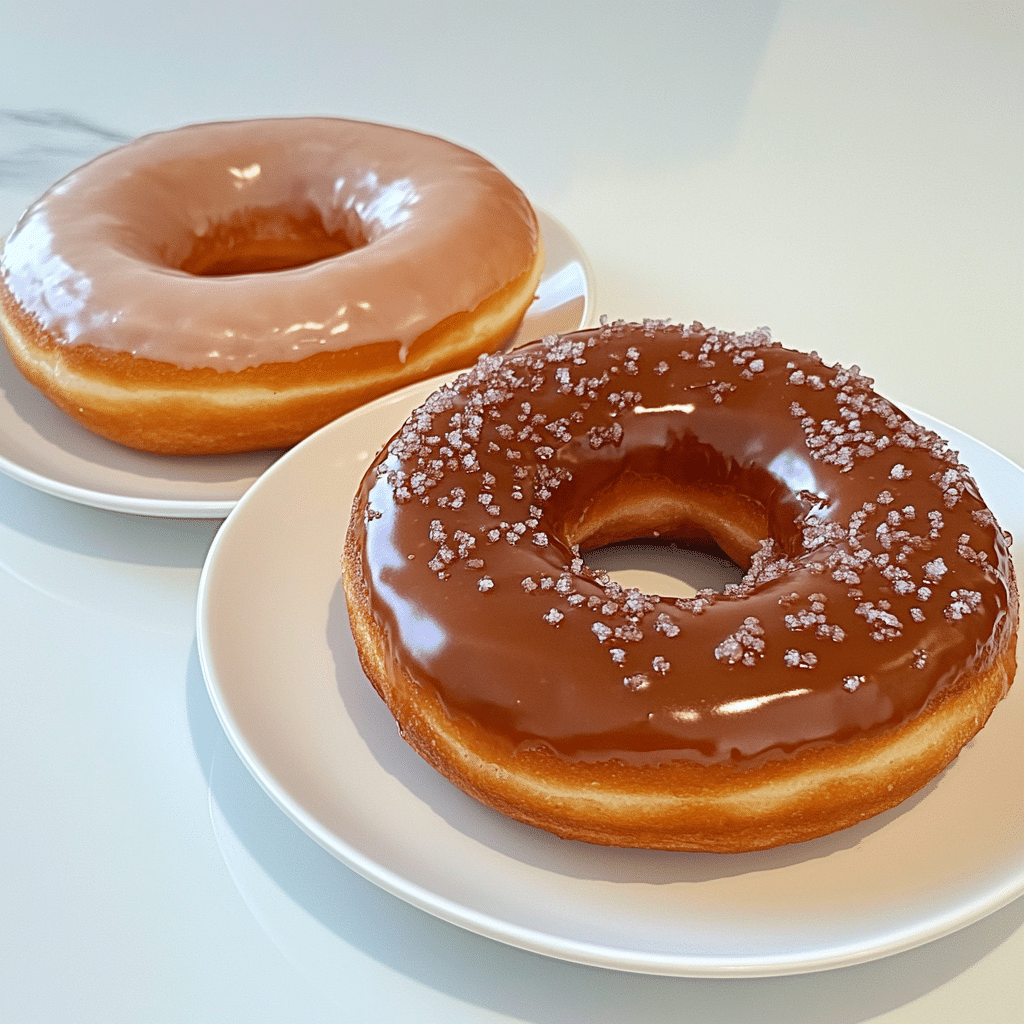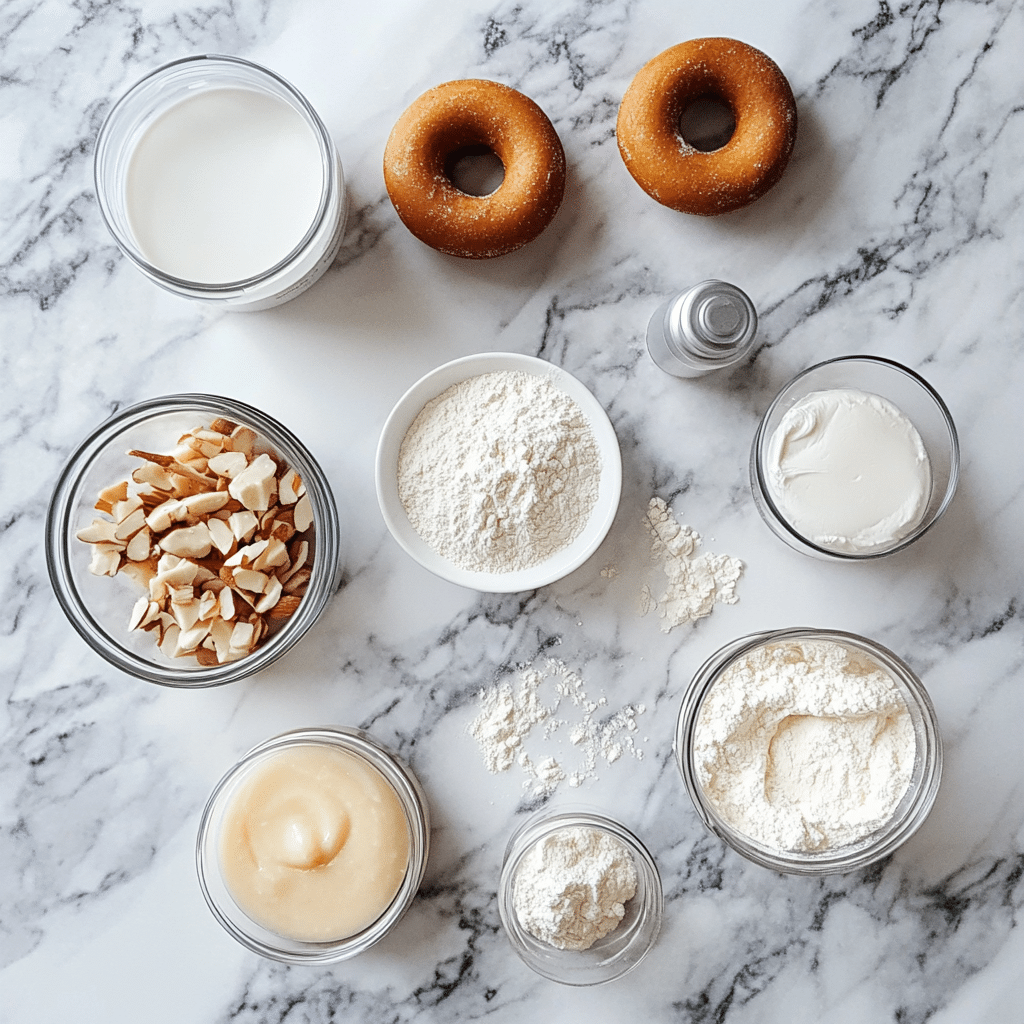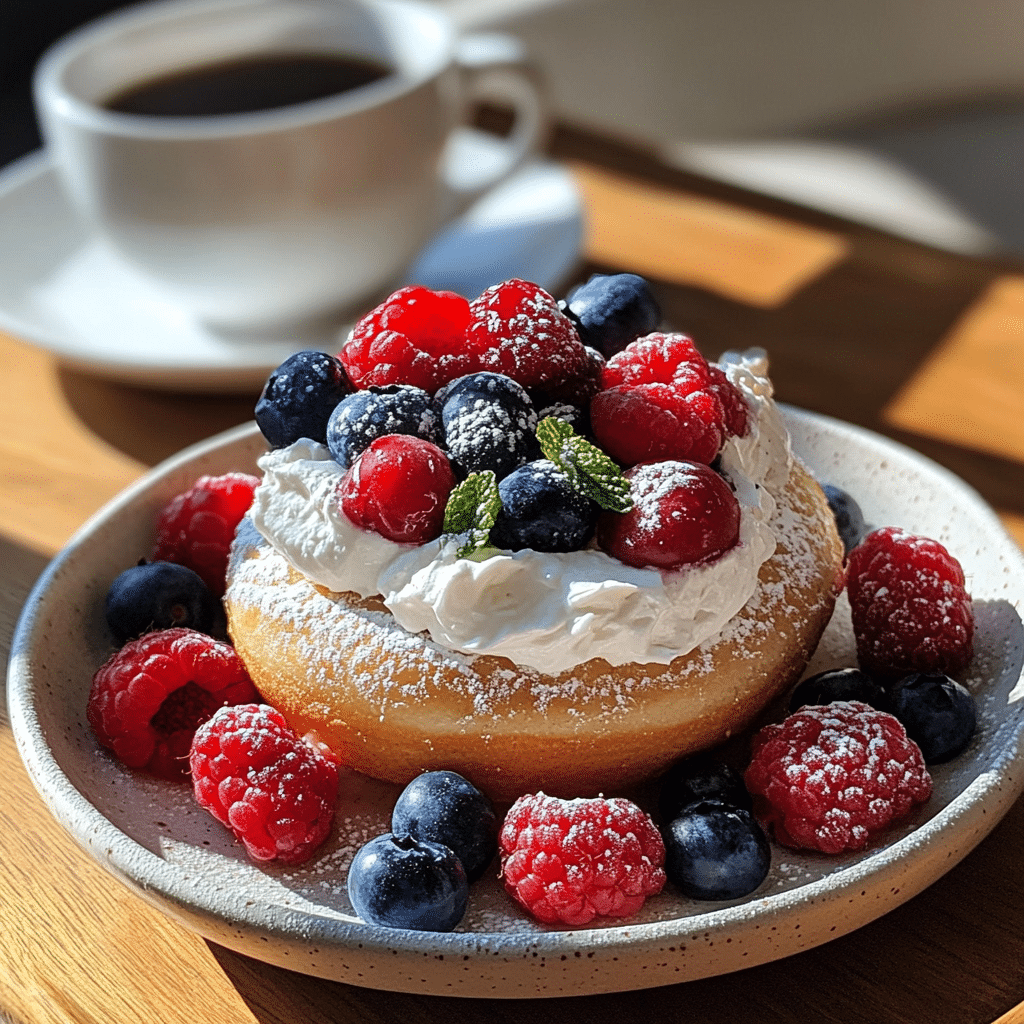Protein donuts are quickly becoming the go-to treat for anyone craving something sweet without ditching their health goals. These guilt-free, high-protein alternatives to traditional donuts are making waves in kitchens, cafes, and fitness circles alike—and for good reason. They’re light on sugar, big on flavor, and packed with the kind of nutrition that supports active, busy lifestyles.
As a chef who’s made it my mission to create delicious, energizing meals, I can tell you: there’s real joy in biting into a dessert that doesn’t sabotage your goals. Whether you’re fueling up before a workout or simply want a better snack option for your family, this guide breaks down everything you need to know about protein donuts—from what sets them apart, to how to make your own that actually taste amazing.
Don’t miss our favorite Protein Donuts Recipe for a simple, delicious way to get started at home.
Table of Contents
Table of Contents
PART 1: What Are Protein Donuts?
What Makes Protein Donuts Different From Regular Donuts
Let’s get real—traditional donuts might taste great, but they come with a cost. Deep-fried, sugar-packed, and made with refined white flour, they spike your energy and crash it just as fast. Protein donuts, on the other hand, are intentionally designed to nourish and satisfy. They’re usually baked, not fried, and they pack a serious punch of protein thanks to ingredients like whey, casein, or plant-based powders.
Here’s how they compare nutritionally:
| Nutrient | Traditional Donut (1 glazed) | Protein Donut (homemade) |
|---|---|---|
| Calories | ~250–300 | ~150–200 |
| Protein | 2–4g | 12–18g |
| Sugar | 15–20g | 4–8g |
| Fat | 12–15g | 5–9g |
That’s the kind of snack you can feel good about—whether it’s post-gym, mid-morning, or tucked into a kid’s lunchbox.
Check out our latest High Protein Donuts picks for more tasty, muscle-fueling ideas.
The Rise of High-Protein Desserts in Fitness and Wellness Culture
It’s not just athletes who are leaning into high-protein desserts. From college students to parents juggling three kids and a job, people are waking up to the idea that smart snacking can taste just as indulgent as traditional sweets.
Protein donuts are part of that evolution. They represent a new kind of comfort food—one that supports recovery, balances blood sugar, and keeps cravings in check. With the right blend of ingredients, you get a fluffy, golden-brown donut that’s just as satisfying as the kind you remember from childhood—but a whole lot better for you.
And hey, if you’re still skeptical, wait until you try the Protein Powder Donuts that taste like cake but work like fuel.

PART 2: Why Protein Donuts Are a Smart Snack Choice
Health Benefits of Protein Donuts
Eating dessert shouldn’t feel like a cheat. One of the most exciting things about protein donuts is that they can actually support your health goals—not sabotage them. Packed with muscle-building protein and often rich in fiber, these donuts offer sustained energy without the sugar crash.
Here are a few benefits that make them a go-to in my kitchen:
- Muscle Recovery Boost: Your body relies on protein to repair tissue and build muscle strength after activity. A donut with 12–18g of protein? Yes, please.
- Blood Sugar Stability: Low in refined sugars, protein donuts help you avoid the glucose roller coaster.
- Keeps You Satisfied: Because they’re rich in protein and fiber, these donuts help curb hunger and reduce snacking between meals.
- Better Fats: Most recipes use healthy fats like coconut oil or nut butter, replacing trans fats and processed oils.
If you’re a snacker or have kids who are always hungry, this is the kind of treat you’ll both feel good about sharing.
Don’t miss our Protein Powder Donuts for a recipe that hits all the marks.
Comparing Macronutrients: Traditional vs. Protein Donuts
Understanding macros (protein, carbs, fat) can help you make smarter choices—especially when it comes to sweets. Here’s a deeper look:
| Feature | Traditional Donut | Protein Donut |
|---|---|---|
| Protein | 2–4g | 12–18g |
| Carbs | 25–35g | 10–20g |
| Fat | 12–15g | 5–9g |
| Sugar | 15–20g | 4–8g |
That’s a serious nutritional upgrade. You get more out of every bite—more flavor, more fuel, more benefits.
PART 3: Key Ingredients That Make the Perfect Protein Donut
Types of Protein Powder Used in Donuts
The heart of every protein donut is, of course, the protein. But not all powders are created equal. Here’s a breakdown of the most popular options you’ll find in recipes:
- Whey Protein Isolate: Great texture and flavor, fast-digesting, not vegan.
- Casein Protein: Slower digesting, thickens batter for a fluffier texture.
- Plant-Based (Pea, Brown Rice, Soy): Ideal for vegans, may need extra binding agents like flax or chia.
- Collagen or Egg White Protein: Low-carb, high-protein—but watch the baking structure.
Pro tip: Always check whether your powder is sweetened and flavored. That can seriously affect your final taste and texture.
Natural Sweeteners, Flours, and Toppings That Keep It Clean
What makes protein donuts special is their ingredient integrity. Instead of white sugar and bleached flour, think nutrient-dense alternatives like:
- Smart Flour Choices: Swap white flour for better alternatives like almond, oat, or whole wheat pastry flours to add nutrients and texture.
- Sweeteners: Maple syrup, honey, coconut sugar, monk fruit, stevia
- Binders: Greek yogurt, applesauce, mashed bananas, or eggs
- Toppings: Crushed nuts, cinnamon, cacao nibs, or sugar-free glaze
This is what allows you to indulge without the crash—a sweet treat that nourishes from the inside out.
Discover great ideas like our Powdered Donuts that use clean toppings with all the flavor.
PART 4: How to Make Protein Donuts at Home
Basic Protein Donut Recipe (Link to Protein Donuts Recipe Post)
Making protein donuts at home is a lot easier than you might think. You don’t need fancy equipment—just a mixing bowl, a whisk, and a donut pan (or even a muffin tin, if you’re flexible with shape). Here’s the basic approach:
Core Ingredients:
- 1 scoop protein powder (whey or plant-based)
- ½ cup almond flour
- 1 egg (or flax egg)
- ¼ cup unsweetened applesauce or Greek yogurt
- 2 tbsp monk fruit syrup
- 1 tsp baking powder
- Dash of cinnamon or vanilla
Instructions:
- Preheat oven to 350°F.
- Mix all dry ingredients in a bowl.
- In a separate bowl, mix wet ingredients. Combine both.
- Pour batter into a greased donut pan.
- Bake for 12–15 minutes. Let cool before adding glaze or toppings.
Don’t miss our full Protein Donuts Recipe for step-by-step photos, variations, and topping ideas.

Baking Tips to Keep Donuts Moist and Fluffy
Protein powder can dry out baked goods if you’re not careful. Over the years, I’ve picked up a few tips that keep protein donuts soft and bakery-worthy:
- Don’t overmix. Stir until just combined to avoid dense texture.
- Watch the bake time. Protein dries faster—remove donuts as soon as they spring back to touch.
- Use moisture-holding ingredients like applesauce, yogurt, or mashed banana.
- Try steam baking. Place a heat-safe dish of water on the lower rack while baking to help maintain moisture in the oven. This keeps your protein donuts from drying out, especially in convection ovens.
Trust me, once you dial in your method, these donuts will disappear off your kitchen counter faster than anything else.
PART 5: Exploring Popular Variations of Protein Donuts
Chocolate, Vanilla, and Cinnamon Protein Donut Options
These high-protein treats aren’t just one-note snacks—they’re a whole dessert universe. Once you’ve nailed the base recipe, the fun really begins. Here are three classic flavor variations that never miss:
- Chocolate Protein Donuts: Add unsweetened cocoa powder, chocolate protein powder, and dark chocolate chips for a fudgy hit.
- Vanilla Protein Donuts: Use vanilla whey protein, a splash of vanilla extract, and a hint of nutmeg for a soft, cake-like flavor.
- Cinnamon Swirl Donuts: Stir in ground cinnamon and top with a drizzle of maple glaze or coconut sugar “crunch.”
These flavor twists are ideal for meal prepping or customizing based on mood, season, or who you’re feeding (kids love the chocolate ones!).
Glazed, Frosted, and Powdered Protein Donuts
Toppings matter. They’re where your healthy baked donuts go from “meh” to “are you sure these are actually good for you?” My go-to finishers:
- Classic Glaze: Blend powdered monk fruit sweetener with almond milk and a touch of vanilla.
- Chocolate Frosting: Melt dark chocolate with a spoon of Greek yogurt for a creamy protein-rich topping.
- Powdered Finish: Lightly dust your donuts with coconut flour mixed with stevia for a powdered-sugar vibe.
Looking for something classic and cozy? Don’t miss our Powdered Donuts recipe that bakes up better than fried.
PART 6: Best Protein Donuts on the Market Today
Top Protein Donut Brands You Can Buy
Not into baking? Don’t worry. The market for high-protein donuts has exploded, and there are some fantastic options that balance taste, texture, and nutrition. Here are my top picks:
- The Protein Donut Co. – Soft, flavorful, and gluten-free.
- Elite Sweets Protein Donuts – 15g protein, low sugar, great post-workout snack.
- Eat Me Guilt Free – Dense and satisfying with up to 14g protein per donut.
- Jim Buddy’s Donuts – Macro-friendly, especially for keto or low-carb eaters.
Always check labels for added sugars and artificial ingredients. The cleanest brands will use whey, stevia, and real food ingredients.
Comparing Taste, Macros, and Price
| Brand | Protein | Sugar | Calories | Price (per donut) |
|---|---|---|---|---|
| Elite Sweets | 15g | 6g | 190 | $3.00 |
| Eat Me Guilt Free | 14g | 7g | 180 | $2.80 |
| The Protein Donut Co. | 12g | 5g | 170 | $3.25 |
| Jim Buddy’s | 10g | 3g | 150 | $2.50 |
Discover great ideas like our High Protein Donuts roundup that compares flavor and nutrition for every lifestyle.
PART 7: Protein Donuts for Fitness Enthusiasts
Pre-Workout or Post-Workout? How They Fit Into Your Fitness Routine
When you’re chasing gains or simply trying to recover right, timing your snacks matters. Protein donuts aren’t just indulgent—they’re functional.
Pre-Workout: Choose a version with a little extra carb (banana, oats, etc.) for quick-release energy.
Post-Workout: Look for donuts high in protein and moderate in carbs to support recovery and muscle repair.
You can even pair them with a shake or black coffee to round out your nutrient intake.
Meal Planning with Protein Donuts (Include Sample Daily Menu Table)
Think donuts can’t fit into a structured meal plan? Think again. Here’s how I build a macro-balanced day with one protein donut in the mix:
| Time | Meal | Protein | Notes |
|---|---|---|---|
| 8 AM | Protein Donut + Almond Milk Latte | 15g | Light but energizing |
| 12 PM | Chickpea Salad + Quinoa Bowl | 20g | Fiber-rich lunch |
| 3 PM | Greek Yogurt + Berries | 17g | Midday recovery |
| 6 PM | Lentil Tacos + Avocado | 22g | Plant-powered dinner |
| 8 PM | Protein Donut or Protein Brownie | 15g | Satisfying evening snack |
That’s over 90g of protein across the day without any sacrifice in flavor or enjoyment.
Check out our full Protein Donuts Recipe to bake your fitness fuel right at home.
PART 8: Common Mistakes to Avoid When Making Protein Donuts
Why They Turn Out Dry or Rubbery
One of the biggest complaints people have when making protein donuts at home is dryness or a rubbery texture. Here’s why that happens—and how to fix it:
- Overusing Protein Powder: Too much protein powder without enough moisture can make donuts chalky.
- Overbaking: Protein bakes faster than regular flour—watch your time and test for doneness early.
- Lack of Fats or Binders: Skipping ingredients like Greek yogurt, eggs, or applesauce can ruin the texture.
Solution? Always balance the batter. Think of it like baking a cake—you want light, moist, and just sweet enough.
Don’t miss our Protein Powder Donuts for a perfect balance of structure and softness.
Ingredient Swaps That Can Make or Break the Recipe
It’s tempting to substitute ingredients when baking, but when it comes to protein donuts, a few wrong swaps can throw everything off:
- Using water instead of milk/yogurt = loss of moisture
- Skipping leavening agents (baking powder/soda) = flat, dense texture
- Using sweetened protein when the recipe calls for unsweetened = overly sweet outcome
When in doubt, stick to the recipe—or test in small batches if you’re feeling experimental. I’ve made every mistake so you don’t have to.
PART 9: Storing and Serving Protein Donuts

Best Practices for Storing Homemade Protein Donuts
If you’re meal prepping or baking in bulk (smart move), storage is key to maintaining freshness. Here’s how I recommend doing it:
- Room Temperature: Keep for up to 2 days in an airtight container.
- Refrigerator Storage: Keep the donuts fresh by placing them in an airtight container and refrigerating for up to five days.
- Freezer: Freeze individually wrapped donuts for up to 2 months. Thaw overnight or pop in the microwave for 15 seconds.
Use parchment paper between layers to prevent sticking.
Creative Ways to Serve Protein Donuts for Breakfast or Dessert
Protein donuts are wildly versatile. Looking for fun ways to enjoy them? Try these delicious and creative serving ideas:
- Protein Breakfast Boost: Split your donut and spread it with almond butter and fresh banana slices for a hearty morning meal.
- Recovery Snack: Enjoy your donut alongside a protein shake or a few nuts to refuel after your workout.
- Sweet Finish: Warm it up and top with coconut cream and seasonal berries for a balanced dessert.
- Mini Party Platter: Make smaller donut holes and glaze in three flavors.
Want to impress your crew? Try dusting them with cocoa powder and crushed pistachios for a gourmet twist.
Check out our Powdered Donuts if you love donuts that double as dessert.
Final Thoughts: Protein Donuts That Taste Good and Do Good
As a chef, a health enthusiast, and someone who just really loves a good dessert, I can confidently say: protein donuts are more than a passing trend—they’re a delicious revolution in how we snack, refuel, and treat ourselves.
They give us the joy of a donut with the staying power of real, functional food. Whether you’re baking them from scratch or grabbing one on the go, you’re choosing a snack that works for your goals, your family, and your taste buds.
I’ve watched these donuts bring kids to the kitchen, help busy adults find better ways to snack, and even satisfy hardcore gym-goers after a tough session. That’s the power of food when it’s done right—simple, soulful, and satisfying.
Looking for more ways to add flavor to your day? Check out our full guide to Protein Donuts and get baking today.
FAQs About Protein Donuts
Are protein donuts actually healthy?
Absolutely! If you use ingredients like almond flour, quality protein powder, and naturally derived sweeteners, protein donuts are a much healthier alternative to regular donuts. They’re higher in protein, lower in sugar, and can support energy, muscle growth, and satiety.
What is the best protein powder for donuts?
Whey protein isolate is a favorite for smooth texture and flavor, but plant-based options like pea or brown rice protein also work well—especially when paired with a binding agent like flax egg or applesauce. Choose unsweetened or lightly sweetened powders for better control over your recipe.
Is it possible to bake protein donuts without a donut mold?
Yes! A muffin tin or small bundt mold works just fine. Just remember to reduce baking time slightly and check for doneness early.
How much protein is in a typical protein donut?
Homemade protein donuts usually contain 12 to 18 grams of protein depending on the recipe. Store-bought options range from 10g to 20g. Always check the label if you’re counting macros.
Can I freeze homemade protein donuts?
Definitely! You can extend shelf life by wrapping each donut separately in parchment or cling wrap, then storing them in a freezer-safe bag for up to two months. Thaw overnight or heat in the microwave for a quick treat.
Do protein donuts taste like real donuts?
When made right, yes! They’re slightly denser than traditional donuts but still moist, fluffy, and full of flavor. The key is using balanced moisture (like yogurt or applesauce) and the right type of protein.
How to make protein donuts?
Making protein donuts is easier than most people think—and it doesn’t require fancy equipment or hours in the kitchen. With just a handful of ingredients and a donut pan (or even a muffin tin), you can whip up a batch that’s soft, satisfying, and packed with muscle-friendly nutrition.
How to make protein donuts?
Making protein donuts is easier than most people think—and it doesn’t require fancy equipment or hours in the kitchen. With just a handful of ingredients and a donut pan (or even a muffin tin), you can whip up a batch that’s soft, satisfying, and packed with muscle-friendly nutrition.
Here’s a simple step-by-step overview:
Choose Your Protein Powder: Use whey, casein, or a plant-based option like pea or rice protein.
Mix the Dry Ingredients: Combine protein powder with flour (almond, oat, or whole wheat), baking powder, and spices.
Add Moisture: Blend in wet ingredients like Greek yogurt, applesauce, eggs (or flax eggs), and your choice of natural sweetener.
Prepare the Pan: Lightly grease a donut pan or muffin tin to prevent sticking.
Bake Smart: Bake at 350°F (175°C) for 12–15 minutes, or until they spring back when touched.
Cool & Glaze: Let them cool, then finish with a glaze, frosting, or healthy topping.
